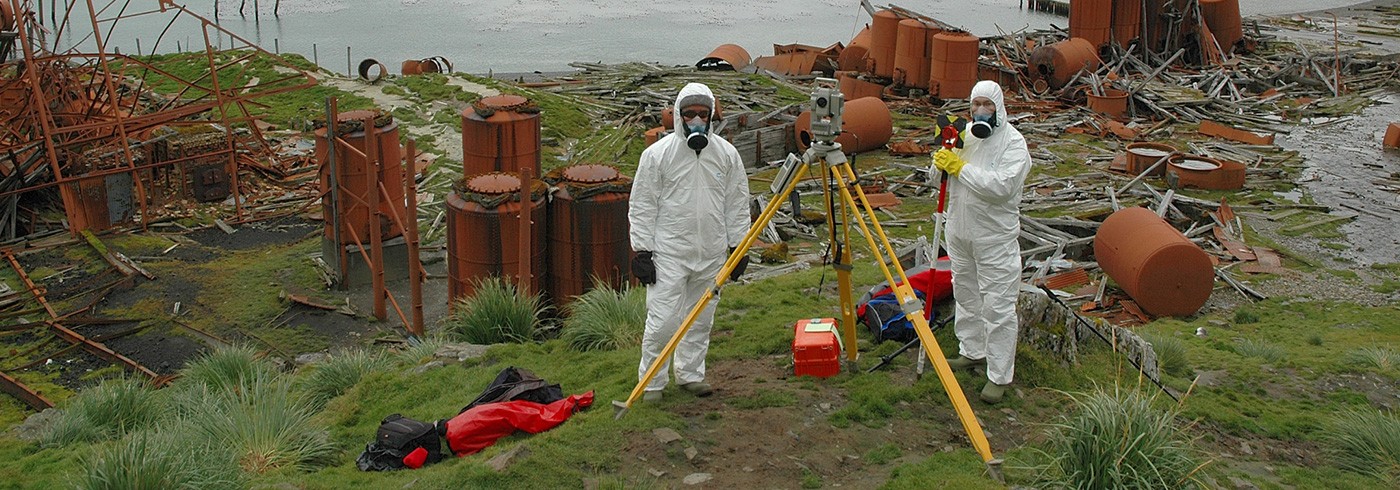LASHIPA 6 – archaeological field investigations of whaling stations at South Georgia
1 March 2009 - 31 March 2009
Cultural heritage or environmental hazard? The South Georgia whaling stations contain important historical information, but also asbestos which makes it necessary to wear protection clothes and masks during field work. Photo: Hamish Laird, Expedition sail.
Aim and research questions
The expedition was carried out as a component of the historical-archaeological research project LASHIPA, a research project within the framework of the International Polar Year 2007–2009. The expedition sought new knowledge in regard of one of the most controversial chapters in the history of the polar areas – the 20th century whaling industry. The expedition documented the remains of two whaling stations on the sub-Antarctic island of South Georgia – Prince Olav Harbour and Ocean Harbour.
The overarching aim of the research project LASHIPA is to explain the historical development of large-scale natural resource exploitation in the polar areas from the 17th century to the present, and the ensuing consequences for the geopolitical situation and the local environment (Avango and Hacquebord 2008).
The data collected by the expedition are being used to answer several important questions regarding the development of the whaling industry in Antarctica. How did the whaling companies design their whaling stations – technologically, socially and for what reasons? What strategies did they develop to adapt whaling to the political, social and environmental conditions of the Antarctic and sub-Antarctic and what strategies did they use to gain control over territories and resources? Did the stations have other functions besides whaling?

Whalers graves on a ridge above the whaling station at Prince Olav Harbour. Some of the graves had iron crosses with names on, others had smaller wooden crosses without names. Did the differences reflect different social categories at the station? Photo: Gustav Rossnes
The fieldwork
The expedition was based on the sailing ship Seal, operated by Hamish and Kate Laird. Fieldwork commenced at Prince Olav Harbour, a sheltered inlet in Possession Bay on the north coast of South Georgia. At this location a South African-British company established a whaling station in 1916, continuing operation until 1931. Although some of the buildings are still standing, most of the station lies in ruins. Due to the presence of asbestos, the team was obliged to work in asbestos protection outfits. The second whaling station mapped by the team was Ocean Harbour, built in 1909 by a Norwegian whaling company and operated until 1920. After closure, the company dismantled the station. With the exception of one standing building, the only remains at the site are foundations and soil imprints.
Essentially, the expedition team employed four different methods when documenting the whaling stations: Dag Avango and Ulf Gustafsson mapped the stations and surrounding landscapes with a total station; in addition, a high quality GPS unit was used for mapping larger landscape features such as coastlines; the expedition photographer Gustav Rossnes compiled a complete photographic documentation using a high quality digital camera; and Bjørn Basberg made measured drawings. In this way, the team mapped, drew and photographed all features at Prince Olav Harbour and Ocean Harbour.

The production area at Prince Olav Harbour whaling station. The open area in the centre is the flensing plane. To the left of it are the remains of the cookeries and a guano factory. To the right is the blubber cookery, laboratory and a butcher shop. Behind is the oil tanks and boilery. Photo: Gustav Rossnes.
Preliminary results
The general structure of the Prince Olav Harbour was similar to other whaling stations at South Georgia, with separate areas for housing, production and livestock. The production system followed a standard pattern – a flensing plane surrounded by cookeries for blubber, meat, bone and steam, including tanks for whale oil. However, the station used an old fashioned technology compared to other Antarctic whaling stations as it lacked the usually clearly visible hierarchical division in the placement of management and workers housing. The differences are partly related to topographical constraints, but most likely they also reflect differences in the industrial cultures of the whaling companies.
The whaling station at Ocean Harbour supplied valuable information on a crucial but often overlooked technological challenge for whaling companies operating in the polar regions: access to freshwater. In places such as South Georgia, most of the freshwater is in solid form (ice). At Ocean Harbour the company secured a constant flow of freshwater by building a dam and a system of water pipes and ditches that led the water to the production plant. Thus, the field results demonstrate that the location of whaling stations was a result of a multitude of factors – reasonable harbour conditions, flat and dry spaces for buildings and production units and access to freshwater.


